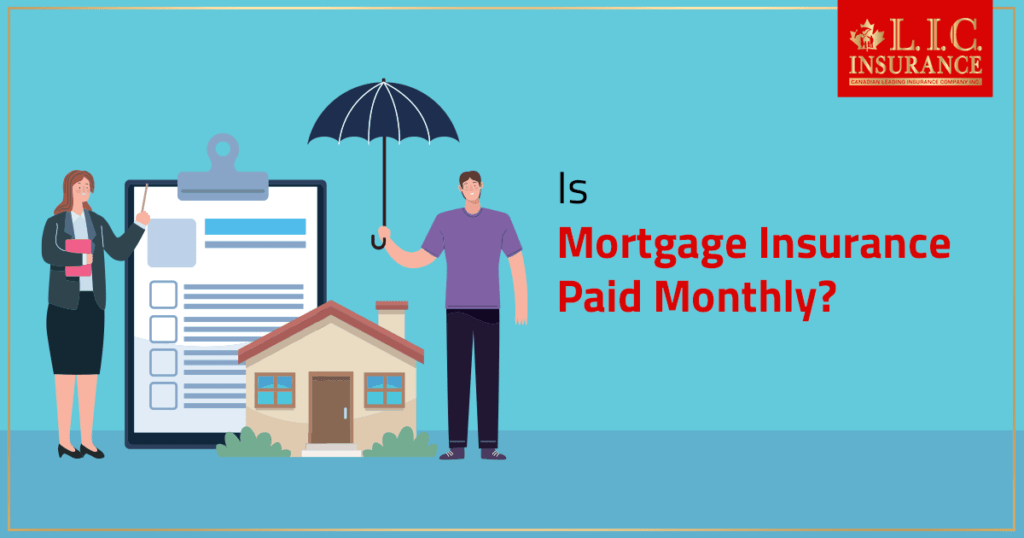
You may be confused about many things related to owning a home, especially when it comes to Mortgage Insurance. You’re not alone. One of the most common questions is, “Is Mortgage Insurance paid monthly?” The goal of this blog is not just to find an answer to this question but also to help you gain financial understanding and control. Continue reading further to get clarification on all your concerns related to a monthly payment of Mortgage Insurance.
Let’s First Understand What’s Mortgage Insurance
Before learning about the payment plans, it’s important first to understand Mortgage Insurance and why it’s so important in the Canadian housing market. Mortgage Insurance basically covers the lender against the risk of default, allowing buyers to become homeowners with a smaller down payment. But how does this need to affect Mortgage Insurance plans and the costs that come with them?
The Necessity of Mortgage Insurance
Let’s suppose that something out of the blue happens in your life that makes it hard for you to make your mortgage payments. Mortgage Insurance is an assurance for lenders that makes sure they’re covered in these cases. It’s this security that allows for more flexible lending criteria, opening the doors to homeownership for many Canadians.
Mortgage Insurance Plans
In Canada, Mortgage Insurance is primarily provided by the Canada Mortgage and Housing Corporation (CMHC), along with private insurers like Genworth Financial Canada and Canada Guaranty. Each of these entities offers Mortgage Insurance plans tailored to various needs, encompassing a range of scenarios from first-time homebuyers to those investing in rental properties.
Explaining How Much Mortgage Insurance Cost
Getting a mortgage requires a lot of knowledge. For many people, the cost of Mortgage Insurance is something that makes them think. It’s something that can change your monthly spending and long-term financial planning in a big way. Let’s learn more about this subject, shall we?
The Core Influencers of Mortgage Insurance Cost
The cost of Mortgage Insurance is not the same for everyone. It depends on a number of important things, including your personal finances and the specifics of the property you want to buy. Here’s a closer look:
Down Payment Size: The amount you’re able to put down upfront plays an essential role. A common misconception is that a larger down payment always leads to a better mortgage rate. While it’s true to an extent, in Mortgage Insurance, the size of your down payment primarily influences your Mortgage Insurance cost.
Generally, a down payment of less than 20% of the property’s value means you’ll need to secure Mortgage Insurance. The smaller your down payment, the higher the risk to the lender and, consequently, the higher your insurance cost.
Property Price: The value of the property you’re purchasing also impacts your monthly Mortgage Insurance premium. Higher-priced homes can lead to higher insurance costs, as the overall loan amount—and thus the risk to the insurer—increases.
The Calculation Problem: Understanding How It’s Done
Mortgage Insurance cost is typically calculated as a percentage of your loan amount. This percentage can vary, sliding in scale based on the equity you have in your home at the time of purchase. But what does this mean in practical terms?
Let’s suppose you’re buying a home with a 10% down payment. Your Mortgage Insurance plan might require a premium that’s calculated at a higher percentage of your loan amount compared to a scenario where you make a 15% down payment. This scale adjustment is designed to reflect the varying degrees of risk associated with different equity levels in the property.
The Mortgage Insurance Struggle Stories
Let’s consider the story of Emily, a first-time homebuyer. Emily found her dream home, but with a limited savings account, she could only afford a 10% down payment. This situation thrust her into the world of Mortgage Insurance plans, where she faced the challenge of understanding how her down payment size affected her Mortgage Insurance cost.
Emily’s journey highlights a common struggle among homebuyers: balancing upfront costs and long-term financial implications. By consulting with Canadian LIC, Emily learned how different down payment sizes could impact her Mortgage Insurance premium. This knowledge empowered her to make the right decision, choosing a Mortgage Insurance plan that suits her financial capabilities and homeownership goals.
Find Out: How to save money on Mortgage Insurance?
Is Mortgage Insurance Paid Monthly?
Moving on to the main point of our conversation, the way Canadians pay for Mortgage Insurance is hard to understand. Initially, it might seem like a simple monthly payment, but the truth is much more than that.
Monthly Payments: The Standard Procedure
When exploring Mortgage Insurance plans in Canada, understanding the specifics of monthly payments can significantly impact your decision-making process. Opting for a plan that incorporates monthly payments into your overall mortgage allows for a smoother financial journey toward homeownership. This strategy not only distributes the Mortgage Insurance cost more evenly but also works well with your existing monthly budgeting practices.
Let’s understand this better with the help of the story of Emma and Luca. Emma and Luca are a couple stepping into homeownership. Like many others, they’re on a tight budget and are concerned about the upfront costs associated with buying a house, including the dreaded down payment and closing costs. The idea of adding another hefty expense in the form of Mortgage Insurance could seem very scary to them.
However, upon discussing Mortgage Insurance plans with their lender, they learn about the option of incorporating Mortgage Insurance costs into their monthly mortgage payments. This revelation comes as a sigh of relief, as it allows them to manage their finances more predictably and avoid the stress of a large lump sum payment upfront.
Find Out: Who pays for Mortgage Insurance?
The Benefits of Monthly Mortgage Insurance Payments
Incorporating the Mortgage Insurance costs into your monthly payments offers a number of benefits:
Budget-Friendly: It fits well with your monthly financial planning, making it easier to manage without feeling the pinch of a substantial one-time payment.
Financial Stability: Spreading the cost over the life of the mortgage ensures that you can maintain financial stability, focusing on other important aspects of your life without worrying about fluctuating insurance costs.
Ease of Payment: By combining your mortgage and Mortgage Insurance payments, you deal with one less bill each month, simplifying your financial commitments and reducing the risk of missed payments.
The Convenience of Monthly Payments in Real Life
To bring this to life, consider the situation of Amir, a single father aiming to provide a stable home for his daughter. With many responsibilities, including work, parenting, and managing household expenses, the thought of additional irregular financial obligations is overwhelming. Learning that his Mortgage Insurance cost could be bundled into predictable monthly payments is a game-changer. This arrangement allows Amir to focus on what matters most, providing for his family, without the added stress of unpredictable financial burdens.
Other Payment Options
However, Mortgage Insurance payments are not just limited to monthly installments. Borrowers have the flexibility to choose from several payment plans, including:
Single upfront payment: An option where the entire Mortgage Insurance premium is paid at the time of purchase. This choice can lead to long-term savings by eliminating the need for monthly premiums.
Blended payments: A combination of upfront and monthly payments, offering a middle ground for those looking to balance immediate and ongoing costs.
Our clients, John and Sarah, were eager to purchase their first home and faced the common dilemma of managing Mortgage Insurance costs. After consulting with their lender, they opted for monthly Mortgage Insurance payments, finding it to be a practical solution that allowed them to budget more effectively without compromising their dream of homeownership.
Find Out: Everything you need to know about Mortgage Insurance
Closing Remarks
Being a homeowner is a big deal, but it also comes with a lot of financial responsibilities, like paying for Mortgage Insurance. By now, it should be clear whether Mortgage Insurance is paid monthly in Canada, as well as the flexibility and options accessible to homebuyers.
With this information, you should now better understand Mortgage Insurance and make choices that are right for your budget and your goals for becoming a homeowner. Remember that making smart decisions is the way to get your dream home, and learning all about Mortgage Insurance is a very important step on that path.
Get The Best Insurance Quote From Canadian L.I.C
Call 1 844-542-4678 to speak to our advisors.

Faq's
If you buy a home with less than 20% for a down payment, that’s when Mortgage Insurance plans come in. This insurance is a requirement for buyers who can’t make a 20% down payment, offering mortgage lenders security and buyers the chance to leap into homeownership sooner.
Mortgage Insurance protects the seller in case you don’t pay back your loan when you buy a home with less than a 20% down payment. While you pay for Mortgage Insurance, the lender is the one who gains from it. You can buy your dream home with this agreement instead of waiting years to save up for a big down payment. This gives you more trust as you move toward homeownership.
The Mortgage Insurance cost isn’t directly tax-deductible for most homeowners. However, there are exceptions, especially if you’re purchasing a rental property. For personal residences, though, the cost of Mortgage Insurance integrates into your loan, and while not deductible upfront, it plays a part in the overall financial planning of buying a home. It’s essential to consult with a tax professional to explore any possible avenues that might benefit your specific situation.
It doesn’t cover damage to the home or protect you if you’re unable to make payments due to job loss or health issues. Instead, Mortgage Insurance protects the lender so they won’t be left without money if you can’t pay your mortgage. It’s like a promise that makes lenders feel safe giving you a loan, so you can become a homeowner even if you don’t have a lot of money for a down payment.
When you go out shopping, you see prices vary based on what you’re buying, right? Similarly, the cost of Mortgage Insurance varies based on several factors, including the size of your down payment and the total amount of your loan. It’s typically a percentage of your mortgage amount.
The smaller your down payment, the higher the risk to the lender and, consequently, the higher your insurance cost might be. Getting a clear picture of these costs early on can help you plan your finances more effectively.
Mortgage Insurance premiums are fees paid to obtain Mortgage Insurance, enabling homebuyers to secure a loan with a down payment of less than 20%. These premiums protect lenders if a borrower can’t repay the loan. The cost depends on your down payment size and loan amount and can be paid upfront or added to monthly mortgage payments, facilitating easier access to homeownership for many.
Absolutely! If you can afford to make a down payment of 20% or more of the purchase price of your home, you can generally avoid the need for Mortgage Insurance altogether. This saves you money over time that you might have spent on insurance premiums.
Yes, it’s possible under certain conditions. Once you’ve built up enough equity in your home—typically when you’ve paid down your mortgage to the point where you owe less than 80% of your home’s value—you can request to cancel your Mortgage Insurance. It’s a bit like reaching a milestone in a long journey, offering you the chance to reduce your monthly expenses.
Imagine your Mortgage Insurance premium as an extra item in your grocery cart, something you pay for alongside your regular items. Instead of paying for it separately, Mortgage Insurance premiums can be added to your monthly mortgage payment. This way, you can handle it all in one transaction, making your financial management smoother and more streamlined. It’s a convenient solution that lets you focus on the more enjoyable aspects of homeownership.
Yes, think of it as choosing between different routes to get to your favorite vacation spot. One alternative is a “piggyback” loan, where you take out a smaller second mortgage to cover part of your down payment. This can sometimes eliminate the need for Mortgage Insurance.
Another option might be lender-paid Mortgage Insurance, where the lender pays the insurance premium upfront but typically charges a higher interest rate on your loan. Exploring these options with a financial advisor can help you find the best path to your homeownership goals.
Just as you might consult a map for directions, the best place to start is by talking directly with lenders or a financial advisor. They can provide detailed, personalized information based on your specific situation. Additionally, reputable websites such as the Canada Mortgage and Housing Corporation (CMHC) offer a wealth of information on Mortgage Insurance, including calculators to help estimate your potential costs.
Just as your life evolves, so can the cost of your Mortgage Insurance under certain conditions, but it’s rare. Generally, your Mortgage Insurance cost is determined at the outset of your loan and doesn’t change. However, if you refinance your home and increase the loan amount or extend your amortization period, your premium might change.
Are you dreaming of a shortcut that lets you bypass Mortgage Insurance altogether? If you’re able to make a down payment of 20% or more, you can indeed waive goodbye to Mortgage Insurance. Some lenders may also offer lender-paid Mortgage Insurance plans, where they cover the cost, but typically this comes with higher interest rates. It’s like paying a bit extra for a direct flight to avoid layovers—it can be more convenient, but it comes at a cost.
Mortgage Insurance isn’t a forever companion on your homeownership journey. Once you’ve paid down your mortgage to the point where your loan-to-value ratio hits 80% or less, you can start the process to stop Mortgage Insurance. Keep in mind that stopping Mortgage Insurance usually requires a formal request from your lender and sometimes an appraisal to confirm your home’s value hasn’t decreased.
The above information is only meant to be informative. It comes from Canadian LIC’s own opinions, which can change at any time. This material is not meant to be financial or legal advice, and it should not be interpreted as such. If someone decides to act on the information on this page, Canadian LIC is not responsible for what happens. Every attempt is made to provide accurate and up-to-date information on Canadian LIC. Some of the terms, conditions, limitations, exclusions, termination, and other parts of the policies mentioned above may not be included, which may be important to the policy choice. For full details, please refer to the actual policy documents. If there is any disagreement, the language in the actual policy documents will be used. All rights reserved.
Please let us know if there is anything that should be updated, removed, or corrected from this article. Send an email to [email protected] or [email protected]

